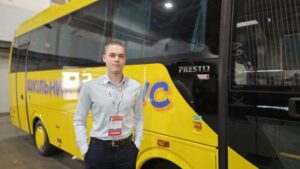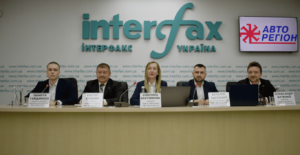
Sales of new buses (excluding minibuses) in Ukraine in January-September this year increased by 20% compared to the same period in 2024, reaching 613 units, of which 91% were small buses, according to Mykyta Haidamaha, head of the Temsa project at Auto-Region.
“2025 was a year of quiet but important changes for the Ukrainian bus market. After two years of uncertainty and declining purchases by the private sector, the market is gradually recovering – not thanks to large contracts or foreign investment, but through local decisions, municipal tenders, and transport renewal programs for communities,” he told Interfax-Ukraine.
He emphasized that school, municipal, and suburban transportation account for most of the demand and keep the market afloat, whereas five years ago, private carriers and travel companies were the main players.
In addition, businesses and private and state-owned enterprises use buses to transport personnel.
According to data provided by Haidamaha, domestic manufacturers were the leaders in the bus segment in January-September: Ataman from the Cherkasy Bus factory with 244 units, followed by ZAZ buses manufactured by the Zaporizhzhia Automobile Plant with 136 units, and in third place were Etalon buses manufactured by the Chernihiv Automobile Plant, with 120 units.
“This demand is facilitated by the school vehicle fleet renewal program, which continues even in wartime,” the expert noted.
At the same time, he noted unexpectedly active dynamics in the sales of large-class buses: in the first nine months of 2025, sales increased 2.7 times – to 37 units, or 6% of the market.
“Isuzu Citiport (20 units), Iveco Urbanway (5), and Troliga Pegasus (6) are reappearing on the roads, mostly in cities that are gradually upgrading their public transport,” said Haidamaka.
He added that the process is not yet large-scale, but it is indicative: city authorities are beginning to think of large buses not as a “luxury” but as an element of infrastructure. Technical requirements are also gradually changing—today, Euro6 diesel engines predominate, but electric solutions are being tested in parallel.
Another interesting factor, according to him, is passenger capacity: while the 16-25 seat segment remains the largest (68%), the 26-29 seat segment has become the most dynamic: its share has grown from 20% (25 units) in September 2024 to 35.8% (39 units) in September this year.
“Such buses are more convenient for suburban routes — more passengers without additional fuel costs, and carriers are looking for the right balance,” says Haidamaha.
Speaking about the presence of Turkish manufacturer Temsa’s buses on the market, he noted that seven buses of this brand were registered in Ukraine in nine months, compared to 15 last year, but the trend towards purchasing models with Euro6 engines continues, so there is a possibility that demand will grow.
Haidamaha also provided statistics on bus registrations by region – the most active is the Sumy region (65 units), followed by Kyiv (63), Lviv (53), and Mykolaiv (41) regions.
At the same time, the highest growth in registrations was in Rivne region (6.6 times), Ternopil region (5.5 times), Sumy region (2.8 times), and Lviv region (+71%).
“These are the regions where communities are most active in attracting state programs and grant funds. The capital, on the other hand, is the focus of imported supplies — more than 60% of Kyiv’s buses are of foreign origin,” he stressed.
Touching on the topic of electric buses, Haidamaka noted that only two electric buses were registered in the first nine months of 2025.
“They are already operating on routes. Ukrainian cities are only just forming the infrastructure for charging, and it is these isolated registrations that show the direction of movement towards the Green Deal,” Haidamaka believes.
In his opinion, 2026 will be a year of contrasts: school buses will remain a stable source of domestic demand, while city operators will gradually begin to transition to new environmentally friendly solutions — Euro6, hybrids, and electric.

Auto-Region, the exclusive distributor of Turkish Temsa buses in Ukraine, plans to sell about 100 buses of this brand in 2024, which will increase its market share to 10% compared to 2% in 2023, when 20 buses were sold, said Mykyta Haidamakha, head of the bus production department.
“Last year our share was 2%, but this was the beginning of a joint production of buses with Temsa in Ukraine, and this year we plan to sell at least 100 buses primarily through participation in the School Bus state program,” he said at a press conference at the Interfax-Ukraine agency on Wednesday.

He clarified that to date the company has managed to achieve a localization level of almost 20%, and is now working to increase this share this year to 25%, taking into account the requirements of the localization law.
According to him, two models are now localized in Ukraine: the Prestij SX intercity bus with 30 seats and a school bus based on this model.
“As of today, the first production batches of these models are at the final stage of production and will be available for order starting in April,” the expert specified.
At the same time, he added that for the implementation of the production program, large contacts have already been signed with Ukrainian component manufacturers.
As the head of the company’s sales department, Oleksandr Butenko, clarified, Ukrainian components in the bus include seats, double-glazed windows, autonomous heating systems, and interior furnishings.

“Currently negotiations are underway with a Ukrainian company about installing a Smart Bus system, and this is a warning system that can find the nearest shelters, and even allows parents to see their children on the bus,” Butenko clarified.
Haidamakha, in turn, emphasized that the company is currently developing a large investment project and plans to protect it with the aim of starting production in Ukraine of all buses of the Temsa model line.
“In particular, yesterday we received the first updated model of a tourist bus with 55 seats, we are attracting engineers to study the product, and we will look for ways to localize it here,” he said.
In addition, the possibility of creating a school bus with an electric motor is being considered, the project of which is planned to be implemented in the near future.
According to him, the Temsa school bus is significantly more expensive than models from domestic manufacturers, its cost is UAH 4 million 950 thousand
“But we do not set the goal of competing on price. The main goal that we have set with our partners is not so much the development of production as the transfer of experience and standards operating in the world to Ukraine. We want to show by our example that such transport is more expedient, and change the existing market in Ukraine,” Haidamakha emphasized.
He expressed the opinion that Ukraine, when forming a state transport strategy, needs to understand how certain savings in procurement will then result in overpayment in the future, when the need arises to replace it with equipment that meets European standards.
Haidamakha noted that today in Ukraine many tenders for the supply of electric buses with funds from European financial institutions remain without applications and are postponed due to the fact that manufacturers cannot fulfill the customer’s conditions.
In addition, in his opinion, the bottleneck in the localization law is the inability to cover the existing demand in Ukraine for the supply of tourist buses for government agencies.
Auto-Region, BUS, Haidamakha, koralp, Kovbik, Pasichnyi, School bus, school transportation, smart bus, Temsa, Братчикова, Бутенко